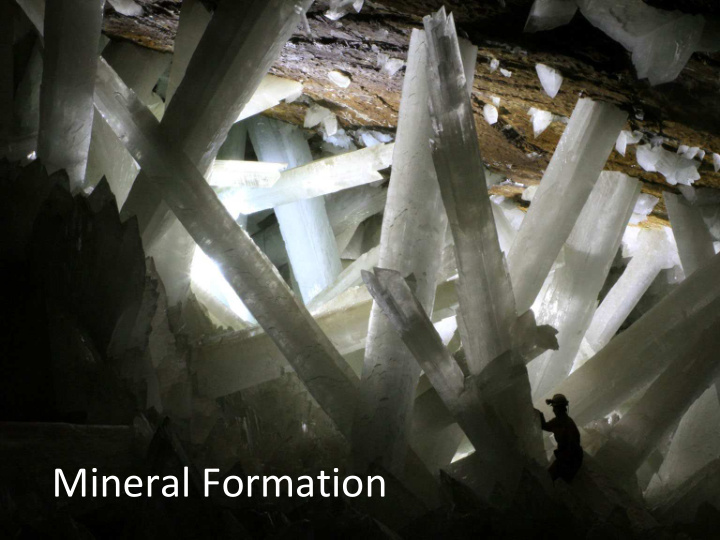



Mineral Formation
Mineral Chemistry General Notes – jot form Mineral Formation Precipitation Solid state reactions Definition: Definition: Examples - Examples - Magma Crystallization Definition: Examples -
Mineral Chemistry • Minerals are made from elements and compounds • The bonds between atoms creates a structure Covalent Bonding - sharing of electrons between atoms - weaker type of bond - very common in minerals Example: SiO2 = Quartz Ionic Bonding - transferring of electrons - one atom has + charge and one - charge - stronger type of bond Example: Halite = NaCl (salt) Metallic Bonding - electrons move from one atom to another - Responsible for shiny metallic appearance Examples: Gold and Silver
Mineral Chemistry Minerals can be described by their chemical formula. Sometimes multiple elements can fill the same spot in a mineral structure. Example Garnets A 3 B 2 (Si 3 O 12 )
Garnets X 3 Y 2 (Si 3 O 12 )
Mineral Chemistry Every mineral is a combination of elements; the atoms are organized into geometric structures called crystals or crystal lattices. The shape of the mineral is determined by how the atoms creating the mineral are organized. If two different minerals have the same chemical formula but different crystal structure, they are called polymorphs (e.g., graphite and diamond). They are both made up of Carbon = C
Crystals form by a seed Mineral Formation (nucleation), which other atoms attach to through bonding. The youngest part of the crystal is at its outer edge. If the atoms available in the environment change, the composition of the mineral can change, thus creating compositional zoning. Watermelon Tourmaline If space to grow is not constrained then crystals will form a characteristic shape based on their structure. However, growth is often restricted, and their shape is controlled by the shape of their surroundings. Plagioclase Zoning (Ca and Na)
Mineral Chemistry General Notes – jot form Mineral Formation Precipitation Solid state reactions Definition: Definition: Examples - Examples - Magma Crystallization Definition: Examples -
Mineral Formation: Precipitation Mineral Precipitation: is when a mineral forms by crystallization from a solution (for example salt precipitating from a salty lake when the water evaporates). ● Natural waters like lakes, oceans and groundwater contain dissolved minerals such as salt or iron. ● Water can only hold a certain amount of dissolved minerals before it becomes saturated. ● When the amount is too great to stay dissolved in the water (supersaturated) the particles come together to form mineral solids and precipitate out. ● For example, when water evaporates from a lake or ocean, it leaves behind a solid “precipitate” of minerals. ● When minerals precipitate below earth’s surface it is because hot water (hydrothermal fluid) changes temperature, pressure or composition, such that the fluid becomes supersaturated and deposits the dissolved minerals. If the water is flowing through cracks, the precipitated minerals form veins .
Mineral Precipitation Examples Quartz veins in a gold mine Geodes – quartz = amethyst. Also, can be calcite or apatite Potash = Sylvite Halite Anhydrite Salt flats – evaporated sea
Mineral Precipitation Examples Limestone cave Quartz veins (Box Mine, SK)
Mineral Formation: Igneous Crystallization Igneous Crystallization: is when a mineral forms by solidification of magma (deep in the earth) or lava (on the surface) . ● The magma composition changes over time as different minerals crystallize out of the magma. ● The sequence of minerals that grow is called Bowen's Reaction Series. ● When magma cools slowly larger minerals can form, when it cools more quickly the crystals are smaller. ● Lava on Earth’s surface can cool so quickly that minerals don’t have time to nucleate and grow and then you get volcanic glass (obsidian).
Bowen’s Reaction Series
Granite is a felsic rock that contains the minerals quartz (grey), plagioclase feldspar (shiny white), potassium Diabase is a mafic rock that in this case feldspar (pale pink) and biotite (black). contains plagioclase (white), pyroxene (brown) and amphibole (black).
Solid State Reactions (Metamorphism) Garnet is a common metamorphic mineral that forms at moderate to high temperatures and pressures.
Metamorphic Reactions Sedimentary rock = sand (quartz) plus clay (kaolinite) Quartz + Kaolinite Increasing temperature Pyrophyllite + Increasing pressure Water Andalusite + Quartz + water Sillimanite + Kyanite + Quartz + water Quartz + water
Mineral Formation: Biomineralization Biomineralization: is when a mineral is formed by living organisms - often in order to strengthen existing tissue. ● Over sixty different minerals have been identified in organisms. ● Most common bio-minerals are phosphate and carbonate salts of calcium that are used with polymers such as collagen and chitin to give structural support to bones and shells. ● There is a lot of research being done to try to understand it better. ● In humans biomineralization helps make up our bones and teeth.
Biomineralization Examples Teeth and bone in Seashells, crustaceans, turtle Bacteria producing gold mammals and birds shells, and corals
Safety: Geode Lab ● Tie long hair back ● Wear Goggles ● Alum powder may irritate your skin; wash your hands if you touch it ● Use extreme care around the boiling water.
Recommend
More recommend